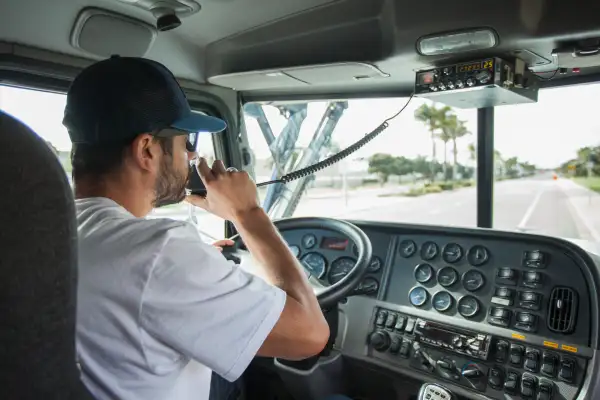How To Hire Truck Drivers

Trucking companies move 71% of all goods in the US, making them instrumental to the commerce industry. However, thanks to a nationwide supply crisis impacting everything from food availability to construction supplies, trucking companies are experiencing one of the worst driver shortages in decades.
You’re probably very aware of the current shortage within the trucking industry and are maybe wondering how to go about hiring a driver. Here are a few tips that should make hiring truck drivers much easier.
Table of Contents:
- Identify the type of truck driver you need
- Familiarize yourself with local and state laws
- Confirm your business insurance covers truck drivers
- Create postings on job sites
- Vet and interview candidates
- Onboard new drivers
- Bottom line on how to hire truck drivers
Identify the type of truck driver you need
When searching for new truck drivers, figuring out which type of driver you need is a great place to start. There are various types of truck driving jobs available, each with different certifications and requirements.
Dry Van Trucker
These drivers haul nonperishable and dry goods in a single trailer and typically don’t unload the materials.
Flatbed Trucker
These drivers haul oddly shaped or overly wide loads that are still within routine permit limits. They tend to be paid more due to the more advanced skills needed to complete those trips.
Tanker Trucker
These drivers transport both hazardous and nonhazardous materials and have a specific Class of Commercial Driving License, (CDL) called a Class C.
Heavy Hauler or Oversized Load Trucker
These drivers transport shipments that are considered overweight or oversized. While each state has its own regulations to determine what’s outside of regular permit limits, the federal government offers the following guidelines: 8.6 feet in width, 13.6 feet in height, 48 to 53 feet in length. Heavy haulers generally require additional certifications.
Long-Haul and OTR Trucker
Long-haul and over-the-road truckers transport goods weighing up to 26,000 pounds at least 250 miles but can go up to 1,000. They are the backbone of the U.S.’ goods transportation system and can also be known as OTR truckers or "over the road" drivers.
Refrigerated freight hauler
These drivers transport goods in refrigerated trucks (or reefers), as the name says. They need to be able to monitor temperatures and possibly make small repairs to ensure temperature control and other technical issues. Time and distance management is critical for this type of driver.
Ice Road Trucker
These drivers tend to stick to the Northern parts of the United States and Canada, transporting goods only deliverable by transfer trucks. They need to be extremely skilled as these particular types of trips can be very dangerous.
Car Hauler
These drivers transport automobiles and also require more skill as these trips are typically very heavy and require great skill to navigate.
Owner-operator
These drivers own their own trucking business. While they can make more money on each load, they also manage all the responsibilities and liabilities on their own.
Familiarize yourself with local and state laws
Once you’ve determined the type of driver you need to hire, it’s time to consider the different local and state laws that apply depending on the type of driver and truck, cargo, and the final destination. Federal, state and local laws and ordinances all regulate trucking operations, including: maximum load weight, CDL training and testing requirements, insurance requirements, road and fuel taxes, and vehicle size.
Trucking is a highly regulated industry that requires Commercial Driving License (CDL) training and licensing for all drivers, though each state has different testing standards. A CDL or commercial driver's license enables drivers to transport large, heavy, or hazardous loads within the United States.
Some states allow you to hire part time drivers while others require all drivers to be full time employees.
In order to operate buses, tankers or vehicles carrying hazardous materials, you need specific endorsements with your CDL, all of which require a specific written knowledge test. Here is a quick rundown of the different types of CDL truck driving licenses drivers can apply for:
- Class A CDL: required to transport goods weighing over 26,001 pounds and covers tractor trailers, flat beds, livestock trailers and most Class B and C requirements depending on the specific endorsement you need.
- Class B CDL: required to drive any vehicle not attached to a trailer and tends to cover school buses, dump trucks, and box trucks to name a few.
- Class C CDL: Required to drive a single vehicle weighing less than 26,001 pounds. This particular class also allows drivers to transport 16 passengers including the driver.
- P (Passenger): This endorsement allows drivers to operate vehicles that seat 16 people or more (including the driver themselves).
- T (Tank): This type of endorsement is required to drive double and triple trailers.
- H (Hazardous Materials): H endorsements are required to drive and operate vehicles that transport hazardous materials.
- S (School Bus): Before earning an S endorsement, drivers must first obtain a P endorsement. Aside from the written knowledge test, drivers must also fill out separate application forms, pay fees, and pass a background check.
Finally, any motor carrier or freight brokering service will also need several registrations and licenses in order to operate. Federal requirements are handled by the Federal Motor Carrier Safety Administration (FMCSA), which oversees the registrations for the United States Department of Transportation (USDOT) number and the authority to operate (MC Number).
Confirm that your business insurance covers truck drivers
Before you hire any full time or part time driver, make sure your business insurance covers the truck driver position you're trying to fill. All truckers will need to have commercial auto insurance — but other insurance types, such as trucking general liability insurance, business interruption insurance and motor cargo coverage can also help fill out possible gaps.
Some insurance companies will cover truck drivers whereas others require drivers to have their own insurance. Other companies may require two years driving experience before covering the driver.
Call your insurance provider to discuss the specific standards or requirements needed for proper coverage.
Create postings on job search sites
According to the ATA or American Trucking Association, 40% of driving schools closed after COVID-19 lockdowns. Driver recruiting is more competitive than ever due to the shortage of qualified drivers.
You can start your search by posting on a job website, whether it’s a job board or a job search engine. The best job posting sites for employers will enable you to tailor your search in order to access a wide pool of qualified candidates, help you with applicant screening and matching, and even have applicant tracking systems to aid with interview scheduling.
Aside from posting to a job board, think outside the box and consider also reaching out to drivers using social media platforms such as Facebook and Instagram.
Check your job description and make sure it’s both accurate and appealing. Don't just post what you need, but also describe what you offer as a company, and consider including salaries/rates, schedules, distances, and haul info, if possible. The best job search sites have found that transparency, concision, and a clarity around expectations are the keys to a successful posting.
The more information you can provide to sites like ZipRecruiter, the more traction you will gain. For instance, how much home time will the driver have? What will be the pay per mile? Answering these types of questions in your job posting can make a real difference in how many candidates apply.
When you’re crafting your job opening and thinking about how to hire employees, consider also that the truck driving industry has a notorious turnover rate coming in at a whopping 90%, with drivers often leaving in search of better wages or benefits. Job retention is a challenge, but here are a few tips to diminish the turnover rates:
- Reward and recognize employees for their accomplishments.
- Be upfront and honest in communicating your expectations.
- Keep wages competitive.
- Implement training programs and procedures.
Vet and interview candidates
Even though truck driver jobs are in demand, you want to make sure whoever you hire adequately represents your company. Just like any interview process, be sure to run background checks on your drivers before awarding them the position.
It is also important to make sure your drivers are somewhat mechanically inclined, even just having a grasp on emergency truck maintenance is highly valuable.
Being more technologically adept and having sound math proficiency is also very important, particularly if drivers are required to use telematics and tracking technologies in the course of their employment.
A few questions to ask:
- Can they handle stressful situations professionally?
- Are they a team player?
- Have they ever missed a deadline or had a delay in shipment? If so, how did they handle it?
- Ask them to give a rundown of their professional driving experience, including any accidents, special licenses, violations, etc.
- Can they be diplomatic and personable?
- How do they remain alert and ensure road safety procedures are always implemented?
Onboard new drivers:
If your candidate makes it through the interview and vetting process, let them know they landed the job as soon as possible.
Most companies provide an acceptance window of 2-3 business days, during which they have their new employees sign a contract. Onboarding typically includes salary details, vacation time, and other benefits, as well as conflict resolution so that every base is covered. New hires should also expect a training period before fully starting their new position.
Once they are officially employees, set up a training period making sure both you and they feel comfortable handling the job.
Bottom line on how to hire truck drivers:
- Do your research on state and local laws as well as insurance company requirements
- Create an alluring and creative job posting
- Interview and vet all potential drivers
- Hire and onboard your new driver(s)
